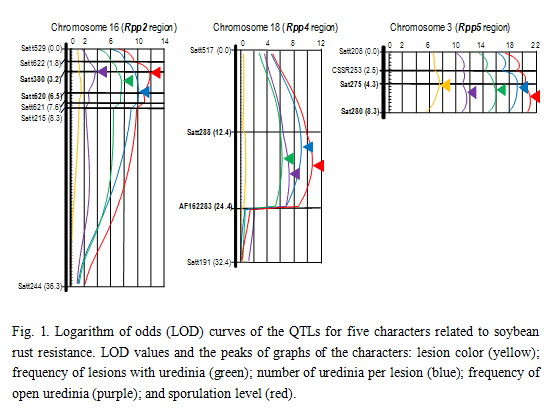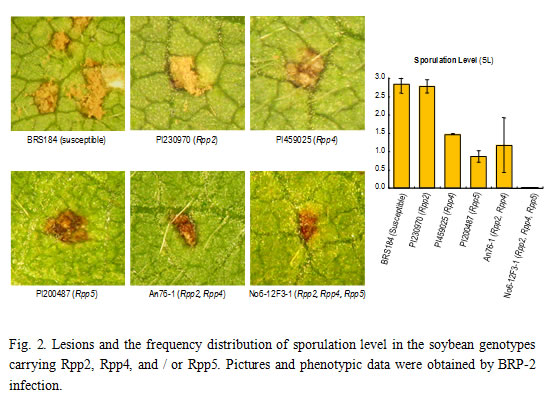Soybean line carrying multiple resistance genes against soybean rust
Description
Sustainable soybean production in South American countries such as Brazil, Argentina, and Paraguay is very important because more than half of soybean in the world market is produced in this region and because about 95% of soybean consumption in Japan is dependent on import. In the last 10 years, however, soybean rust has become one of the most serious threats to soybean production in this region causing large yield reduction. Thus far, five resistance loci to this disease have been identified and used for soybean breeding. However, some resistance alleles of these genes were reported to have broken down. The aim of this study was to clarify soybean-rust resistance by pyramiding these resistance genes and to develop soybean line carrying multiple resistance genes for marker-assisted breeding program in South American countries.
An F2 population segregating Rpp2, Rpp4, and Rpp5, was infected with highly virulent Brazilian rust population-2 (BRP-2). Quantitative trait locus (QTL) analysis revealed that all three genes genetically contributed to the phenotypes of five resistance characters: lesion color; frequency of lesions with uredinia; number of uredinia per lesion; frequency of open uredinia; and sporulation level in a different manner (Fig. 1). Digenic and trigenic interactions were also detected among these thee genes. A soybean line, No6-12F3-1, was screened and identified to carry these three resistant alleles as homozygous by means of marker-assisted selection. It was also identified to have higher resistance than its ancestors, PI230970 (No.3, Rpp2), PI459025 (Bing Nan, Rpp4), PI200487 (Kinoshita, Rpp5), and An76-1 (Rpp2 and Rpp4) by preventing uredinia and spore production in the infections of BRP-2 and its single-uredinia isolates, BRP-2.1, BRP-2.5, BRP-2.6, and BRP-2.49 (Fig. 2).
By using polymorphic DNA markers sandwiching each resistance locus, the presences of three kinds of resistance alleles were successfully identified in the line, No6-12F3-1. In addition, high resistance derived from candidate genetic interactions were observed in this line. Therefore, three resistance genes in this line can be introduced into susceptible soybean varieties in the marker-assisted backcross breeding to confer rust-resistance to susceptible varieties. When this line is used for breeding, however, we must consider that 1) polymorphic DNA markers will be chosen depending on susceptible recurrent parents, 2) high resistance is not always guaranteed because the degree of resistance could be changed by the pathogenicity of rust races and the genetic background of susceptible recurrent parents, and 3) the frequency of backcrossed progenies expected to carry three resistant alleles may be low because of the recombination between resistant loci and DNA markers.
Figure, table
- Affiliation
-
Japan International Research Center for Agricultural Sciences Biological Resources and Post-harvest Division
- Classification
-
Administration A
- Research project
- Program name
- Term of research
-
FY 2011 (FY 2010-FY 2015)
- Responsible researcher
-
Yamanaka Naoki ( Biological Resources and Post-harvest Division )
MIERUKA ID: 001770Lemos Noelle Giacomini ( JIRCAS Visiting Research Fellowship Program )
- ほか
- Publication, etc.
-
Lemos et al. (2011) Euphytica 182(1):53-64
Yamanaka et al. (2011) JARQ 45(4):385-395
- Japanese PDF
-
2011_09_A4_ja.pdf137.67 KB
- English PDF
-
2011_09_A4_en.pdf221.17 KB


